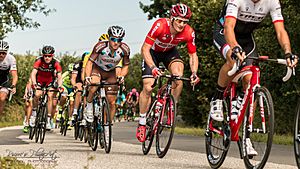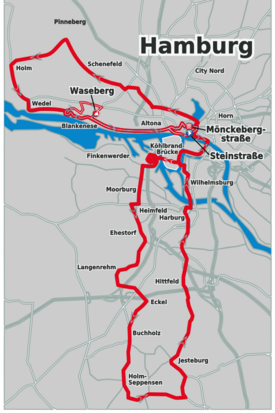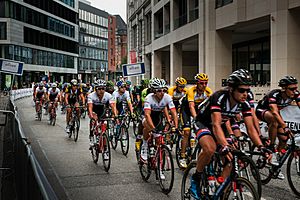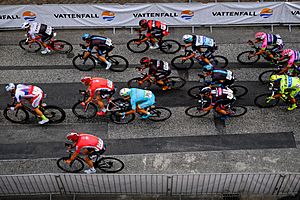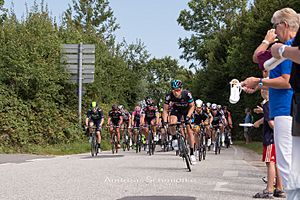Hamburg Cyclassics facts for kids
 |
|
| Race details | |
|---|---|
| Date | Mid to late August |
| Region | Hamburg, Germany |
| Discipline | Road |
| Competition | UCI World Tour |
| Type | Single-day race |
| History | |
| First edition | 1996 |
| Editions | 27 (as of 2024) |
| First winner | |
| Most wins | |
| Most recent | |
The Hamburg Cyclassics is a big annual bike race held in and around Hamburg, Germany. It's also known as the Bemer Cyclassics because of its main sponsor. This exciting event is a one-day race for both professional cyclists and amateur riders. The race route changes a bit each year, but it's usually around 250 kilometers long. One of the toughest parts of the course is the Waseberg hill. Riders have to climb this hill three times near the end of the race!
Until 2016, this was Germany's only race on the UCI World Tour calendar. The UCI World Tour is like the top league for professional cycling races around the world. The race is organized by IRONMAN Unlimited Events Germany GmbH.
A super cool part of the Cyclassics is the Jedermannrennen, which means "Everyman's race." This is a special event for amateur cyclists held on the same day and roads as the professional race. Bike fans can choose to ride 55 km, 100 km, or 155 km. Lots of people want to join, so only 22,000 amateur riders can participate. Tickets often sell out months in advance!
Contents
History of the Hamburg Cyclassics
How the Race Started: HEW Cyclassics

The Hamburg Cyclassics began in 1996. It was a smaller professional race back then. The very first race was the shortest ever, only 160 kilometers long. An Italian rider named Rossano Brasi won it. The first main sponsor was HEW, which stood for Hamburg's Electricity Works.
In 1997, Jan Ullrich won the second race. This happened just two weeks after he won the famous Tour de France! Because of his win and the huge crowds, the race quickly became very popular.
By 1998, cycling was growing fast in Germany. The Hamburg Cyclassics became part of the UCI Road World Cup. This was a series of the ten most important one-day races in cycling. The Hamburg race took the place of the Wincanton Classic from Britain. A Dutch rider, Léon van Bon, won the third race. The distance was increased to 253 kilometers.
Erik Zabel was another German winner in 2001. In 2002, a Belgian rider named Johan Museeuw won his last World Cup race. He was known as a "classics specialist" because he was great at these one-day races.
New Sponsors: Vattenfall and EuroEyes
In 2002, the race sponsor HEW was bought by a Swedish company called Vattenfall. Vattenfall became the new main sponsor in 2006. The race was then called the Vattenfall Cyclassics. In 2005, the race joined the new UCI ProTour, which replaced the World Cup.
After 2009, the Hamburg Cyclassics was the only big German race at the highest international level of cycling. Since 2011, it has been one of the races in the UCI World Tour. The UCI, which is the world cycling organization, decided to keep the race on the World Tour until at least 2016.
Because most of the course is flat, the race is often won by sprinters. These are riders who are very fast in the final dash to the finish line. Since 2004, the race has almost always ended with a big group sprint. Famous sprinters like Robbie McEwen, Óscar Freire, Alexander Kristoff, and André Greipel have won this race. American sprinter Tyler Farrar is the only rider to win the race twice, in 2009 and 2010.
In 2013, there were protests during the race. People in Hamburg were unhappy with Vattenfall's environmental plans.
In 2015, Vattenfall decided not to sponsor the race anymore. The organizers needed to find a new sponsor. From 2016, EuroEyes became the new main sponsor. EuroEyes is a large German company that helps people with laser eye treatments. Australian sprinter Caleb Ewan won the race in 2016.
The Race Route
The Hamburg Cyclassics usually starts in the old town of Hamburg and finishes on Mönckebergstraße. This is a very famous shopping street in the city center. The race distance is usually between 225 and 255 kilometers. The course is mostly flat and goes through the countryside around Hamburg. The exact route changes a little each year, but the finish line stays in the same spot.

The biggest challenge on the course is the Waseberg hill. It's in Blankenese, a part of Altona, west of Hamburg's city center. Near the end of the race, riders do three smaller loops that include the Waseberg. They climb it first when they are about 69 kilometers from the finish. Then they climb it again at 28 kilometers and a final time at 15.5 kilometers from the finish.
The Waseberg is a steep, paved hill that goes up from the Elbe river. It's 700 meters long and has a very steep part that goes up 16%. It's extra hard because riders hit a sharp turn right before the climb. This means they have to quickly change gears. Teams try to get their best riders to the front before the climb. This makes the narrow roads leading to the hill very fast and exciting. The route also goes over the Köhlbrandbrücke, which is Hamburg's tallest bridge.
From 2005 to 2014, the first half of the race went south towards Lüneburg Heath. Then riders came back to Hamburg and went west for the final loops.
In 2015, the organizers changed the route to celebrate the race's twentieth year. The race started in Kiel, which is about 90 kilometers north of Hamburg. Riders then cycled southwest through Schleswig-Holstein to Hamburg. The total distance was shorter, at 222 kilometers. However, the final part of the race, with the three climbs of the Waseberg and the finish on Mönckebergstraße, stayed the same. The route from Kiel to Hamburg was also chosen to help promote the cities' plan to host the 2024 Summer Olympics.
The race director, Roland Hofer, said that even though the course looks good for sprinters, any type of great rider can win it. He felt this kind of race was important for a balanced World Tour event. He also mentioned that the World Tour came to Germany during a "comeback" for German cycling. This was because recent successes were making people interested in the sport again.
Race Winners

| Rider | Team | |||
|---|---|---|---|---|
| ↓ "HEW Cyclassics" ↓ | ||||
| 1996 | Rossano Brasi | Team Polti | ||
| 1997 | Jan Ullrich | Team Telekom | ||
| 1998 | Léon van Bon | Rabobank | ||
| 1999 | Mirko Celestino | Team Polti | ||
| 2000 | Gabriele Missaglia | Lampre–Daikin | ||
| 2001 | Erik Zabel | Team Telekom | ||
| ↓ "Vattenfall Europe Hamburg" ↓ | ||||
| 2002 | Johan Museeuw | Domo–Farm Frites | ||
| 2003 | Paolo Bettini | Quick-Step–Davitamon | ||
| 2004 | Stuart O'Grady | Cofidis | ||
| 2005 | Filippo Pozzato | Quick-Step–Innergetic | ||
| ↓ "Vattenfall Cyclassics" ↓ | ||||
| 2006 | Óscar Freire | Rabobank | ||
| 2007 | Alessandro Ballan | Lampre–Fondital | ||
| 2008 | Robbie McEwen | Silence–Lotto | ||
| 2009 | Tyler Farrar | Garmin–Slipstream | ||
| 2010 | Tyler Farrar | Garmin–Transitions | ||
| 2011 | Edvald Boasson Hagen | Team Sky | ||
| 2012 | Arnaud Démare | FDJ–BigMat | ||
| 2013 | John Degenkolb | Argos–Shimano | ||
| 2014 | Alexander Kristoff | Team Katusha | ||
| 2015 | André Greipel | Lotto–Soudal | ||
| ↓ "EuroEyes Cyclassics" ↓ | ||||
| 2016 | Caleb Ewan | Orica–BikeExchange | ||
| 2017 | Elia Viviani | Team Sky | ||
| 2018 | Elia Viviani | Quick-Step Floors | ||
| 2019 | Elia Viviani | Deceuninck–Quick-Step | ||
| 2020 | No race | |||
| ↓ "Bemer Cyclassics" ↓ | ||||
| 2021 | No race | |||
| 2022 | Marco Haller | Bora–Hansgrohe | ||
| 2023 | Mads Pedersen | Lidl–Trek | ||
| 2024 | Olav Kooij | Visma–Lease a Bike | ||
Riders with Multiple Wins
| Wins | Rider | Years Won |
|---|---|---|
|
|
2017, 2018, 2019 | |
|
|
2009, 2010 |
Wins by Country
| Wins | Country |
|---|---|
| 9 | |
| 4 | |
| 3 | |
| 2 | |
| 1 |
See also
 In Spanish: Cyclassics Hamburg para niños
In Spanish: Cyclassics Hamburg para niños


